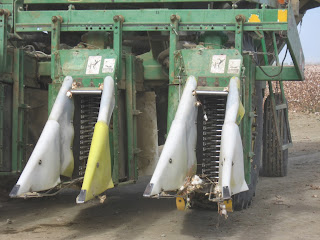The photographers jostled and elbowed their way to the
front, trying to capture the perfect photo.
As one photographer grabbed a shot and quickly retreated,
another slid in into the throng with paparazzi-like quickness. The gathering “oohed”
and “aahed” as they inched closer to catch a glimpse of the rotating spindles
of the cotton harvester. Did I say cotton harvester?
 |
| Grower Randy Bettencourt, right, describes harvester. |
Yes, the star attraction of this photo shoot was a green machine.
It wasn’t any ordinary piece of hardware. It was a machine that harvests
high-quality cotton grown in the northern San Joaquin Valley. Only in farm
country does a cotton harvester get the paparazzi treatment.
 |
| Close-up shot of a spindle. |
Why the Hollywood treatment in the middle of a dry, dusty
cotton field? The reason is simple: How often do city folks have an opportunity
to see up close and personal with a huge cotton harvester in action – with
sharp metal spindles spinning around a couple feet away.
“It was great. It was really educational,” remarked Nina
Koske, one of 100 people who spent last Tuesday visiting cotton fields,
watching cotton being harvested and touring a cotton gin in the nation’s
agricultural heartland. This was the Sustainable Cotton Project’s annual Cotton
Tour, which drew participants from across California as well as Oregon and
Florida.
Throughout the day, participants armed with smart phones,
video cameras and 35 mm cameras snapped an endless stream of photos and footage,
ranging from shots of sugar bushes populating a Westside perennial hedgerow to
shots of fluffy cotton bolls.
 |
| Gathering takes photos are taken with paparazzi-like zeal. |
The Cotton Tour is unique – there are few, if any, such free
day-long programs around that are open to the public. The event attracts wide
spectrum of people, including representatives from the USDA, state water
agencies, major fashion brands, upstart fashion design industry, textile
companies, art and design colleges as well as folks just interested in farming
and cotton.
This year’s tour brought another big turnout. Participants learned
about federal water allocations – or lack of it this year – the importance of
farming to the Fresno County economy, good bugs and pests, cotton ginning and,
of course, cotton growing and harvesting.
“It was great to see the start to finish of California
Cleaner Cotton™,”
Tony Jagoda of San Francisco said, referring to the trademarked cotton grown by
farmers in the SCP program.
 |
| Participants enjoyed seeing a harvester's spindles in action. |
One of the featured attractions was a cotton harvester
operating on Randy Bettencourt’s 2,000-acre cotton field. As the harvester reached
the end of a row and prepared to turn around, the farmer asked the driver stop
for a few minutes at the edge of a dirt road to give the tour group a birds-eye view of the machine.
“Don’t touch anything on the machine,” Randy warned the
camera-toting gathering. “There are sharp points. “There are thousands of fingers (spindles)
that go around to pick the cotton.” Randy went on to describe the operation: After
the fiber is plucked from the plant, the cotton is sucked up into a basket at
the rear of the harvester. “Everything has to work perfectly.”
The group nodded and snapped more photos.
Watch for future posts
about the tour and, as one participant put it, learn the “A to Z of California
cotton farming.”
No comments:
Post a Comment